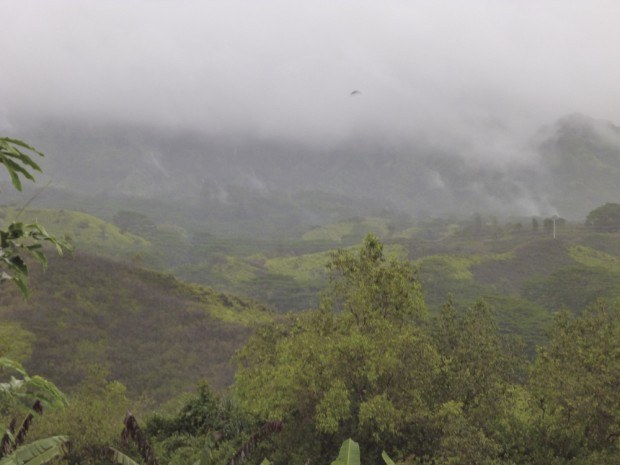LIHU‘E — False information was presented to the public during a meeting last month regarding the proposal for a high-elevation horizontal well on Kaua‘i, according to the head of the county Department of Water. DOW Manager David Craddick said Oceanit
LIHU‘E — False information was presented to the public during a meeting last month regarding the proposal for a high-elevation horizontal well on Kaua‘i, according to the head of the county Department of Water.
DOW Manager David Craddick said Oceanit Laboratories Inc. — the consulting firm hired by the DOW to conduct an environmental impact statement — is to blame for a portion of public opposition and misunderstanding surrounding the project.
There is no plan to drill into Mount Wai‘ale‘ale, he said.
“Our consultant showed a misleading map at the meeting. A map that was never a part of our plan.”
The map detailed five possible locations for the two-mile horizontal well, including one that ran to Kawaikini Peak, on the edge of Mount Wai‘ale‘ale’s culturally significant Blue Hole. The actual proposed locations are in the upper elevations of the south fork of the Wailua Watershed, near Mount Kahili.
“We were trying to do everything right, but then we kind of got sideswiped by this drawing showing us going into the Wai‘ale‘ale area,” Craddick said.
Due to a malfunction of the projector, Craddick was forced to leave the April 11 meeting early, and was not made aware that the incorrect location had been presented until a week later.
“If I would have seen (the map) at the meeting, I would have made an attempt to correct it right there on the spot,” he said.
Moving forward, Craddick said the DOW’s priority is to ask for the community’s forgiveness and present the correct information about its proposal.
While the scoping comment period ends Friday, Craddick said public comment on the EIS will remain open. The DOW is also planning to hold a series of informational meetings around the island in late May.
“We gave wrong information,” Craddick said. “I cannot minimize that in any way.”
Jan TenBruggencate, who is in charge of community outreach for Oceanit, said the misinformation was nothing more than a clerical error.
“It’s one of those things that happen,” he said, adding that the correct information can be found online.
The benefits of the estimated $50 million high-elevation well would include significant energy savings for the county’s drinking water system, as well as ensure water quality and guarantee a reliable supply, even in the event of a disaster, according to the DOW.
“This is something that will be beneficial for generations of people,” Craddick said. “This well will continue functioning for hundreds of years.”
Debra Lee-Jackson submitted testimony against the proposal on behalf of Hui Ho‘opulapula N Wai o Puna, a group of landowners, lessees, taro farmers, fishermen and native Hawaiians seeking to restore and preserve the waters within the watersheds of the Puna District.
“We demand a reallocation and reservation of the waters of Puna to appurtenant rights, and the traditional and customary right of native Hawaiians, before any other use is expanded or proposed,” she wrote. “We believe that the management of our waters is best determined by the tenants of these lands.”
Don Heacock, an aquatic biologist with the Department of Land and Natural Resources, supported the testimony of Jackson. While he understands the DOW’s goal of conserving energy, Heacock said there is a better alternative than drilling.
“The proposed subject horizontal well is not ecological, will not be economical, will likely have several long-term negative environmental impacts, and there is a far better alternative to lowering groundwater pumping costs,” he wrote in his testimony.
Heacock’s alternative calls for the DOW to work with the state Department of Health to establish a state-level Greywater Administrative Rule, which would allow wastewater from showers and sinks to flow into subsurface pipes that irrigate gardens, trees and lawns. Heacock said 50 percent of potable water used during the summer months on Kaua‘i is for watering lawns and gardens, not for drinking.
“Fresh water is our most limited resource,” he said. “We’re going to have to sit down and seriously discuss how we can balance and conserve our water resources, not just potable water, but our rivers and streams.”
The greywater alternative would not only reduce total potable water consumption, but also recharge the aquifer and increase the efficiency of wastewater treatment, according to Heacock.
Even though Wai‘ale‘ale is not where the DOW intends to drill, Heacock said disturbing the island’s upper watersheds is kapu — forbidden — in Hawaiian culture.
“There’s still huge debate about drilling a hole in any of those mountains,” he said.
While he understands the cultural significance of areas such as Mount Wai‘ale‘ale, Craddick said the proposal would simply allow the DOW to collect the water already being used from closer to the source.
“To go up higher just catches the water before it has a chance to be polluted,” he said.
The DOW proposal would remove a maximum of 8 million gallons of water per day to supply Kapa‘a, Lihu‘e and Po‘ipu, which represents less than 10 percent of the estimated sustainable yield, according to the DOW.
To submit comments or for more information about the proposal, visit www.kauaiwater.org or http://kahili.oceanit.com.
• Chris D’Angelo, lifestyle writer, can be reached at 245-0441 or lifestyle@thegardenisland.com.


